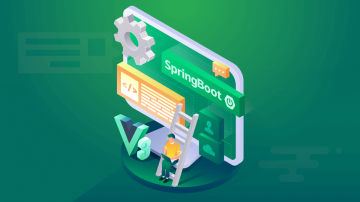本文详细介绍了Spring Boot项目开发的基础知识,包括Spring Boot的简介、优势以及环境配置。通过具体的实例和代码示例展示了如何创建Spring Boot项目,并解析了项目的文件结构。文中还涵盖了Spring Boot的基本配置、控制器开发和数据访问开发等内容。
SpringBoot项目开发入门教程 SpringBoot简介SpringBoot是什么
Spring Boot 是一个基于Spring框架的开源框架,它简化了基于Spring的应用程序开发过程。它通过约定优于配置的原则,让开发者能够快速搭建独立的、生产级别的应用。Spring Boot 不仅仅简化了基础设施的配置,还通过提供多种内置的功能(如自动配置、测试、嵌入式服务器等),使得开发、部署、运行一个Spring应用变得非常简单。
SpringBoot的优势
- 快速应用启动:Spring Boot 提供了一种快速构建应用的方法,通过约定优于配置,简化了Spring应用的初始配置。
- 自动配置:Spring Boot 可以自动配置很多常见的场景,如数据库连接、Web 服务器等,大大减少了开发者的配置工作。
- 嵌入式服务器:Spring Boot 可以直接内嵌一个轻量级的Servlet容器,如Tomcat、Jetty等,使应用成为一个独立的可执行文件,便于部署。
- 依赖管理:Spring Boot 提供了很好的依赖管理功能,开发者不再需要手动管理大量依赖项。
- 生产就绪:Spring Boot 内置了多种生产特性,如健康检查、指标收集等,使得应用更容易在生产环境中部署和监控。
- 丰富的启动器:Spring Boot 提供了大量的启动器(Starter),这些启动器包含了常用的库和配置,使得开发者可以轻松地将应用集成到现有的生态系统中。
安装和环境配置
安装Java环境
Spring Boot 要求 Java 8 或更高版本。可以下载并安装 Oracle JDK 或 OpenJDK。
安装IDE
推荐使用 IntelliJ IDEA 或 Eclipse,这两款 IDE 都提供了对 Spring Boot 的良好支持。
安装Maven或Gradle
Spring Boot 需要使用构建工具来管理项目的依赖关系。常见的构建工具包括 Maven 和 Gradle。安装这些工具后,可以通过它们来构建和运行项目。
安装Spring Boot CLI(可选)
Spring Boot CLI 可以让你通过命令行使用 Spring Boot。安装 CLI 可以简化一些开发任务,例如快速创建项目和运行应用。
创建SpringBoot项目使用IDE创建项目
- 打开 IntelliJ IDEA 或 Eclipse。
- 选择创建一个新的 Spring Boot 项目。
- 选择需要的依赖项。
示例:在 IntelliJ IDEA 中创建一个 Spring Boot 项目
// 创建一个新的 Spring Boot 项目
public class Application {
public static void main(String[] args) {
SpringApplication.run(Application.class, args);
}
}使用Spring Initializr创建项目
访问 Spring Initializr 网站,选择项目所需的技术栈,如 Java 版本、Spring Boot 版本等,然后下载项目并解压。
项目文件结构解析
Spring Boot 项目的典型结构如下:
my-spring-boot-app/
├── src/
│ ├── main/
│ │ ├── java/
│ │ │ └── com/
│ │ │ └── example/
│ │ │ └── myapp/
│ │ │ ├── Application.java
│ │ │ └── controller/
│ │ │ └── HelloController.java
│ │ └── resources/
│ │ ├── application.properties
│ │ └── static/
│ │ └── index.html
│ └── test/
│ └── java/
│ └── com/
│ └── example/
│ └── myapp/
│ └── ApplicationTests.java
└── pom.xmlapplication.properties配置文件
配置 Spring Boot 应用程序的默认属性文件,通常位于 src/main/resources 目录下。配置文件中的属性可以被应用程序中的任何组件读取和使用。
示例:application.properties 文件
# 设置端口号
server.port=8080
# 数据库连接配置
spring.datasource.url=jdbc:mysql://localhost:3306/mydb
spring.datasource.username=root
spring.datasource.password=root
spring.datasource.driver-class-name=com.mysql.jdbc.Driver
# 配置日志级别
logging.level.root=WARN
logging.level.com.example.myapp=DEBUG使用注解简化配置
Spring Boot 提供了许多注解来简化配置过程,如 @SpringBootApplication 注解。
示例:@SpringBootApplication 注解的使用
import org.springframework.boot.SpringApplication;
import org.springframework.boot.autoconfigure.SpringBootApplication;
@SpringBootApplication
public class Application {
public static void main(String[] args) {
SpringApplication.run(Application.class, args);
}
}自动配置原理简介
自动配置是 Spring Boot 的核心特性之一,通过在 META-INF/spring.factories 文件中定义的条件化自动配置类,Spring Boot 可以根据项目中的类和配置项自动生成相应的配置。
示例:META-INF/spring.factories 文件
org.springframework.boot.autoconfigure.EnableAutoConfiguration=\
org.springframework.boot.autoconfigure.admin.SpringApplicationAdminJmxAutoConfiguration,\
org.springframework.boot.autoconfigure.aop.AopAutoConfiguration,\
org.springframework.boot.autoconfigure.amqp.RabbitAutoConfiguration,\
org.springframework.boot.autoconfigure.context.ConfigurationPropertiesAutoConfiguration,\
org.springframework.boot.autoconfigure.context.PropertyPlaceholderAutoConfiguration创建Controller
在 Spring Boot 中,控制器通常通过 @Controller 或 @RestController 注解定义。
示例:创建一个简单的控制器
import org.springframework.web.bind.annotation.GetMapping;
import org.springframework.web.bind.annotation.RequestMapping;
import org.springframework.web.bind.annotation.RestController;
@RestController
@RequestMapping("/api")
public class HelloController {
@GetMapping("/hello")
public String sayHello() {
return "Hello, World!";
}
}简单的HTTP请求处理
控制器可以处理各种HTTP请求方法,如 GET、POST、PUT、DELETE 等。可以通过 @GetMapping、@PostMapping 等注解指定请求的处理方法。
示例:处理 POST 请求
import org.springframework.web.bind.annotation.PostMapping;
import org.springframework.web.bind.annotation.RequestBody;
import org.springframework.web.bind.annotation.RestController;
@RestController
public class UserController {
@PostMapping("/users")
public User createUser(@RequestBody User user) {
// 处理用户创建逻辑
return user;
}
}返回JSON数据
Spring Boot 默认支持 JSON 格式的响应。可以使用 @RestController 注解来返回 JSON 数据。
示例:返回 JSON 数据
import org.springframework.web.bind.annotation.GetMapping;
import org.springframework.web.bind.annotation.RestController;
@RestController
public class DataController {
@GetMapping("/data")
public Data fetchData() {
Data data = new Data();
data.setName("John Doe");
data.setAge(30);
return data;
}
public static class Data {
private String name;
private int age;
public String getName() {
return name;
}
public void setName(String name) {
this.name = name;
}
public int getAge() {
return age;
}
public void setAge(int age) {
this.age = age;
}
}
}使用Spring Data JPA
Spring Data JPA 是一个用于简化数据访问技术的库,它提供了一套用于操作数据库的标准接口。
示例:定义一个简单的实体类
import javax.persistence.Entity;
import javax.persistence.GeneratedValue;
import javax.persistence.GenerationType;
import javax.persistence.Id;
@Entity
public class User {
@Id
@GeneratedValue(strategy = GenerationType.IDENTITY)
private Long id;
private String name;
private int age;
// getters and setters
}连接数据库配置
数据库连接配置需要在 application.properties 文件中指定。
示例:数据库连接配置
# 数据库连接配置
spring.datasource.url=jdbc:mysql://localhost:3306/mydb
spring.datasource.username=root
spring.datasource.password=root
spring.datasource.driver-class-name=com.mysql.jdbc.Driver实体类和Repository接口的定义
在 Spring Data JPA 中,可以定义接口来操作数据库中的数据。Spring Boot 会自动为这些接口生成实现。
示例:定义 Repository 接口
import org.springframework.data.jpa.repository.JpaRepository;
import com.example.myapp.User;
public interface UserRepository extends JpaRepository<User, Long> {
// 自定义查询方法
User findByName(String name);
}示例:使用 UserRepository 查询用户
import org.springframework.beans.factory.annotation.Autowired;
import org.springframework.web.bind.annotation.GetMapping;
import org.springframework.web.bind.annotation.RestController;
@RestController
public class UserController {
@Autowired
private UserRepository userRepository;
@GetMapping("/users")
public List<User> getUsers() {
return userRepository.findAll();
}
}静态资源的访问
Spring Boot 默认支持静态资源的访问,如 HTML、CSS、JavaScript 文件等。这些文件通常位于 src/main/resources/static 目录下。
示例:访问静态资源
在 src/main/resources/static 目录下创建一个 index.html 文件:
<!DOCTYPE html>
<html>
<head>
<title>Home Page</title>
</head>
<body>
<h1>Welcome to My Application</h1>
</body>
</html>使用Thymeleaf模板引擎
Thymeleaf 是一个现代的、功能丰富的模板引擎,支持多种模板类型。Spring Boot 默认支持 Thymeleaf,可以通过 @Controller 注解来使用 Thymeleaf 渲染视图。
示例:使用 Thymeleaf 渲染视图
import org.springframework.stereotype.Controller;
import org.springframework.ui.Model;
import org.springframework.web.bind.annotation.GetMapping;
@Controller
public class WebController {
@GetMapping("/hello")
public String sayHello(Model model) {
model.addAttribute("name", "John Doe");
return "hello"; // 返回模板名
}
}在 src/main/resources/templates 目录下创建一个 hello.html 文件:
<!DOCTYPE html>
<html xmlns:th="http://www.thymeleaf.org">
<head>
<title>Hello Page</title>
</head>
<body>
<h1>Hello, [[${name}]]!</h1>
</body>
</html>前端页面与后端交互
Thymeleaf 可以与前端页面进行交互,通过 Thymeleaf 的表达式来动态地填充或修改页面内容。
示例:前端页面与后端交互
在 src/main/resources/templates 目录下创建一个 user.html 文件:
<!DOCTYPE html>
<html xmlns:th="http://www.thymeleaf.org">
<head>
<title>User Info</title>
</head>
<body>
<h1>User Information</h1>
<div th:if="${user != null}">
<p>Name: <span th:text="${user.name}"></span></p>
<p>Age: <span th:text="${user.age}"></span></p>
</div>
<div th:if="${user == null}">
<p>User not found</p>
</div>
</body>
</html>在控制器中返回用户信息:
import org.springframework.stereotype.Controller;
import org.springframework.ui.Model;
import org.springframework.web.bind.annotation.GetMapping;
@Controller
public class UserController {
@GetMapping("/user")
public String getUser(Model model) {
User user = new User();
user.setName("John Doe");
user.setAge(30);
model.addAttribute("user", user);
return "user"; // 返回模板名
}
}
 随时随地看视频
随时随地看视频




